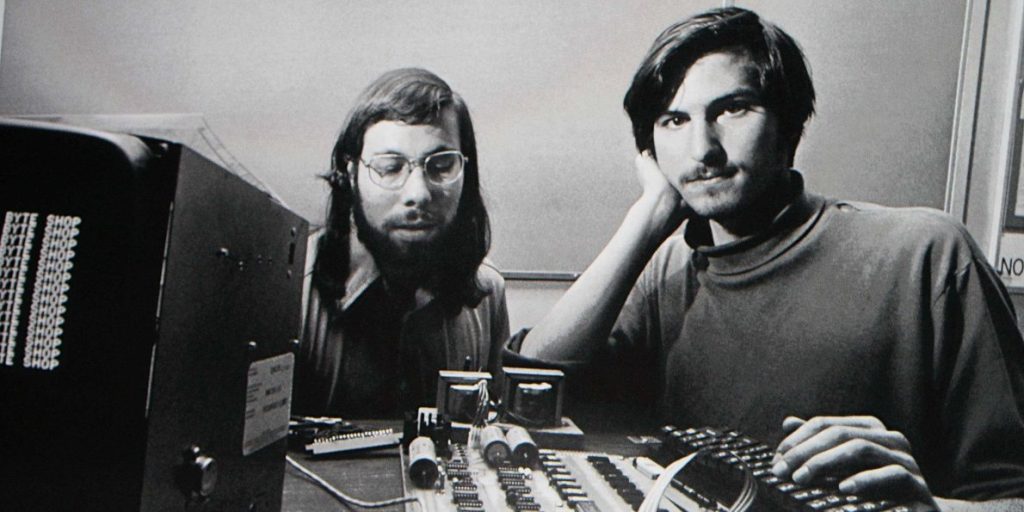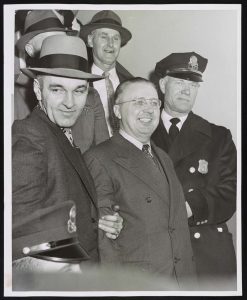Winner of the Fall 2017 StMU History Media Award for
Best Article in the Category of “People”
It was a sunny summer day. A sea of graduates, proud parents, family members, and faculty had their sights fixed on a bony and haggard individual. It seemed age had already taken possession of his body, making him look somewhat fragile and weak. Yet, he radiated forcefulness. The man was none other than Steve Jobs, ready to deliver Stanford’s Class of 2005 Commencement Speech. By that year, Jobs had gone through many hardships—he had been fired from the company he started, and he had undergone intricate medical procedures due to pancreatic cancer, just to name a few. Amidst the tragedies in his life, he transmitted nothing but the serenity of a man that had accomplished what he desired in life. One of his initial remarks was “Your work is going to fill a large part of your life, and the only way to be truly satisfied is to do what you believe is great work. And the only way to do great work is to love what you do. If you haven’t found it yet, keep looking. Don’t settle. As with all matters of the heart, you’ll know when you find it.”1 However, how exactly did Jobs find his dream job? Specifically, what was the genesis of Apple Inc?

“I did go to college… [and] after six months, I couldn’t see the value in it. I had no idea what I wanted to do with my life and no idea how college was going to help me figure it out.”4 In his academic hiatus, Steve encountered many things. He experienced psychedelic drugs, and sought to find spiritual enlightenment in India. He rekindled a friendship that would later serve as catalyst for the creation of the most powerful electronic company of all time, Apple Inc. His friend was Steve Wozniak, a talented, self-taught electronics engineer, whom Jobs had met in his high school years through common friends.5 Like himself, Steve Wozniak was an electronics enthusiast. After having part-time jobs with Atari and Hewlett-Packard, Jobs had found his passion—anything electronics.6 “I was lucky—I found what I loved to do early in life.”7 The two Steves, in love with computers, began their first commercial venture in 1975, when Jobs was only twenty years old.8
Their first creations were called “blue boxes”—electronic boxes that allowed anyone to make cost-free long-distance phone calls.9 Jobs invested $40 in parts and sold the boxes door-to-door in college dorm rooms for $150 apiece, splitting the profits with Wozniak.10 Although their first creation had to be shut down because of its illicit intentions, it proved that the two Steves were perfect business partners. Many attribute Apple’s early success to the natural connection the two Steve’s shared. Wozniak has commented,”we had so much in common. Normally, it was hard for me to explain to people the kind of designs I worked with, but Steve got it right away.”11 Similarly, Jobs explained, “He was the only person I met who knew more about electronics than me.”12 Despite their different personalities, they complemented each other in a wonderful manner. Steve Wozniak contributed with his technological savvy, and Steve Jobs with his entrepreneurial charisma. Aware of this powerful interrelation, they decided to take their collaborative efforts to the next level.

Jobs and Wozniak regularly attended Homebrew Computer Club (HCC), where they swapped ideas with other hobbyists who dreamed of building their own computers.13 It was there that they recognized the market for smaller, cheaper, intuitive, and accessible computer machines for everyday consumers. In his very first HCC meeting, Wozniak recalls, “the complete vision of a personal computer suddenly appeared in my head. That night I began to make sketches on paper of what later became known as the Apple I.14 Just as he had with the blue boxes, Jobs quickly recognize the potential to profit from a computer that Wozniak had designed to show off at the HCC.15
Their new venture—the Apple I. Jobs convinced Wozniak that they should sell the computers as a product. “Steve [Jobs] didn’t do one circuit of design for the first computer…but it was his idea to sell them,” Wozniak recalls.16 In order to finance their bold creation, Jobs parted with his red and white Volkswagen bus for $1,500 and Wozniak with his beloved HP-65 programmable calculator for $250.
Every day after that, Wozniak would work on the first prototype in his Hewlett-Packard cubicle, spreading the pieces out and deciding where they should be placed and welded.17 By 1975, “Woz” had successfully created the first personal computer with a typewriter-like keyboard able to connect to a regular TV as a screen. Just like that, the archetype of the modern personal computer and the start-up of the biggest company in the world was up and running. The two Steves were ready to take their simple computer to the market, but first, they needed a name for their company. As the two drove along Highway 85 between Palo Alto and Los Altos, Jobs blurted out “I’ve got a name: Apple Computer.”18 It was Jobs who came up with “Apple.” He thought the name sounded “fun, spirited and not intimidating.” Although they tried to think of more technical sounding names, nothing was able to beat “Apple Computer.”

Realizing that Apple would be hopelessly deadlocked if they disagreed on any major issues, the two sought someone who could serve as a tiebreaker and help get the company off the ground. That man was Ronald G. Wayne, a video game maker’s chief draftsman. Jobs enticed Wayne to become a partner in Apple by offering ten percent interest in the company, with the remainder split between Jobs and Wozniak. The three formally filed the partnership papers for Apple Computer Company on April Fool’s Day, 1976.19 By 1976, Apple Inc was open for business, and Jobs was only twenty-one years old. Wozniak conceived of a series of user-friendly personal computers, and—with Jobs in charge of marketing—Apple set the list price of the original 4K Apple I at $666.66 each.20 Immediately, Jobs began hustling up customers. Paul Jay Terrel—owner of the first retail computer store chain in the country “Byte Shop”—agreed to buy fifty computers for $500 each, cash on delivery.
The order was placed, the only problem—they had no working station. In a daring move, 11161 Crist Drive in Los Altos (Steve’s home), became the assembly center of the Apple I. The 24-by-24 ft cramped space in Jobs’s garage was transformed into an impromptu workshop. The two Steve’s had thirty full days to complete the Byte Shop’s request. Having no employees, and very little time, the two Steves recruited all available hands, from college students to Jobs’ pregnant sister Patty. Around ten workers were roped in to sit at a kitchen table to solder parts and set up boards. Exceedingly long working hours. Enormous amounts of caffeine. Countless failed models. No sleep. The small garage became so labor intensive that Paul Jobs (Steve’s father), had to stop repairing old cars so that the Apple kids could have all of the garage for themselves. Defying all odds, however, the company’s first batch of Apple I’s was completed within the month. With fifty Apple I’s completed, their first formal contract generated the rookie company a total of $25,000.21

Although there were a few bumps along the road, and a couple of not so successful products, it seemed that every year this company got better and better. They would go on to release trendsetting and ground-breaking products such as the Macintosh with its revolutionary mouse, the MacBook laptop computer, and the ubiquitous iPods, iPhones, and iPads that we cannot live without today. Ultimately, Apple became the most powerful electronic industry of all time. Its dominance is undisputed, generating a colossal $108.25 billion in sales today.
It is truly amazing to see how this company originated in a college drop out’s garage. Jobs’ early career success, dramatic ouster from the company he built, and ultimate transformation of Apple into one of America’s largest multi-billion dollar companies encapsulates the American dream.22 His untimely death left questions unanswered about the products he might have invented or what he might have accomplished later in life. Nevertheless, he made it clear to all that we should strive to reach our dreams, and work hard for them. As he said at the end of his Stanford speech, “Stay Hungry. Stay Foolish.”23
- Steve Jobs, “How to Live before you Die,” (Commencement Address, Stanford University, Stanford, June 12, 2005). ↵
- Walter Isaacson, Steve Jobs (New York: Simon & Schuster, 2011): 52. ↵
- Anna Wong, “A Lesson for Public Schools From Steve Jobs,” The Huffington Post, last modified October 9, 2012 https://www.huffingtonpost.com/anna-wong/steve-jobs-education_b_1762277.html. ↵
- Steve Jobs, “How to Live before you Die” (Commencement Address, Stanford University, Stanford, June 12, 2005). ↵
- International Directory of Company Histories, 2012, s.v. “Apple,” by Scott Lewis, Jeffrey L. Covell and Mark Lane. ↵
- Owen W. Linzmayer, Apple Confidential 2.0: The Definitive History of the World’s Most Colorful Company (San Francisco: No Starch Press, 2004): 2. ↵
- Steve Jobs, “How to Live before you Die,” (Commencement Address, Stanford University, Stanford, June 12, 2005). ↵
- Owen W. Linzmayer, Apple Confidential 2.0: The Definitive History of the World’s Most Colorful Company (San Francisco: No Starch Press, 2004): 2. ↵
- International Directory of Company Histories, 2012, s.v. “Apple,” by Scott Lewis, Jeffrey L. Covell, and Mark Lane. ↵
- Owen W. Linzmayer, Apple Confidential 2.0: The Definitive History of the World’s Most Colorful Company (San Francisco: No Starch Press, 2004): 3. ↵
- Walter Isaacson, Steve Jobs (New York: Simon & Schuster, 2011): 85. ↵
- Owen W. Linzmayer, Apple Confidential 2.0: The Definitive History of the World’s Most Colorful Company (San Francisco: No Starch Press, 2004): 3. ↵
- Owen W. Linzmayer, Apple Confidential 2.0: The Definitive History of the World’s Most Colorful Company (San Francisco: No Starch Press, 2004): 5. ↵
- Walter Isaacson, Steve Jobs (New York: Simon & Schuster, 2011): 170. ↵
- Owen W. Linzmayer, Apple Confidential 2.0: The Definitive History of the World’s Most Colorful Company (San Francisco: No Starch Press, 2004): 5. ↵
- Owen W. Linzmayer, Apple Confidential 2.0: The Definitive History of the World’s Most Colorful Company (San Francisco: No Starch Press, 2004): 6. ↵
- Walter Isaacson, Steve Jobs (New York: Simon & Schuster, 2011): 171. ↵
- Owen W. Linzmayer, Apple Confidential 2.0: The Definitive History of the World’s Most Colorful Company (San Francisco: No Starch Press, 2004): 6. ↵
- Owen W. Linzmayer, Apple Confidential 2.0: The Definitive History of the World’s Most Colorful Company (San Francisco: No Starch Press, 2004): 6. ↵
- Owen W. Linzmayer, Apple Confidential 2.0: The Definitive History of the World’s Most Colorful Company (San Francisco: No Starch Press, 2004): 7. ↵
- Owen W. Linzmayer, Apple Confidential 2.0: The Definitive History of the World’s Most Colorful Company (San Francisco: No Starch Press, 2004): 7. ↵
- Amy E. Hurley-Hanson and Cristina M. Giannantonio, “Academic Reflections on the Life and Career of Steve Jobs,” Journal of Business and Management, no. 1 (2013): 5. ↵
- Steve Jobs, “How to Live before you Die”(Commencement Address, Stanford University, Stanford, June 12, 2005). ↵




110 comments
Rafael Azuaje
30 days to build 50 computers. Early on, Apple computers was a company willing to take risks. If you’ve ever built your own computer you would know that it’s not like assembling ikea furniture. Things can and will go wrong. Steve Jobs and Steve Wozniack managed to pull it off and be profitable. This strategy has payed off in a big way over the years.
100 billion dollars is a lot of money. It is enough to pay off the UK’s $69.6 billion deficit. That would certainly put them in the history books- and possibly throw the UK economy into chaos.
Marco Picardo
Everyone knows what Apple is, and almost everyone has at least one Apple product. However, many lack the knowledge of the people behind Apple’s name. This story is the epitome of The American Dream. A band of college drop outs got together to form a company in a garage that is now worth $108.25 billion. It is quite incredible to think about it in those terms. Overall great article.
Veronica Spryszynski
Great article! I never knew that he started in his late teens years for the invention of apple. This just shows that a college drop out can be successful in life if you really put all your effort into it. Apple products are very famous around the world. The earnings that he made in the 1970’s were very big in value back then and now its a billion dollar product.
Michael Mandujano
This article is very inspirational and the title “We’ll just name it Apple” is clever. In fact, the information that was provided to describe Steve Jobs journey of failures and successes is phenomenal. In fact, it is interesting that Steve Jobs conducted his work alongside a companion that was also named Steve, but Steve Wozniak. Overall, this article was well put together and I enjoyed learning about the history of Apple and how the companies’ products continue to evolve.
Tara Sellers
The only name I ever truly associate with Apple is Steve Jobs. I did not know the name of his partner was Steve Wozniak. The fact that they had to make 50 computers in a month with no formal facility to do it is interesting. This story really shows us how with hard work you can achieve your dreams. The article was very intriguing and well written.
Carlos Aparicio
I am fascinated by the biography of Steve Jobs and the birth of Apple. I found this article very informative because it explains the descriptive life of Steve Jobs and his contribution to the whole world. Apple is one of the worlds best technology company involving smart phones, tablets, computers, TVs, iPods, and even smart watches. The company is huge success and it is all owed to Steve Jobs and his small garage. I enjoyed reading this life-changing article.
Samuel Stallcup
Truly one of the most legendary companies of all time, even if they are not ahead of the game anymore. Every year people are always excited to see what Apple has to offer with their new and latest product, even if they say “Oh, I don’t really like Apple anymore.” It’s really fascinating that a technology company has this big of a hold on nearly every American. This article was well-written and the topic choice was great.
Mariah Cavanaugh
The story of how Apple came to be is such a fantastic story. A college dropout starts fiddling in his garage with a friend and that results in the formation of a company that is now valued at $108.25 billion. The part of this story that really blows my mind is that Ron Wayne cashed out of the company for only $800. That poor guy has got to be kicking himself for that.
Mark Martinez
A well written and put together article that was interesting to read. I always forget how even the biggest companies in the world started at such a simple point. Personally, I can’t even imagine starting any of this and dropping out of school to take such a risk. Even after being fired from his own company Steve Jobs was admired by millions and inspired countless more.
Gabriela Serrato
This article was written well. It flowed nicely from point to point and I was intrigued the entire time. It is sad that we lost Steve Jobs, an incredibly minded man. He was truly inspiring with all that he accomplished in his life. His perseverance makes him stand out because he did all that it took to succeed. His accomplishments did not fall into his hands, but he worked incredibly hard to fulfill his dreams. He was his own motivation to get up every day and make movement happen. I think some may be inspired by him because he was a college drop out, but forget that he put in massive amounts of work to obtain his success. People should idolize his determination along with the fact that he defied the odds by not completing college.